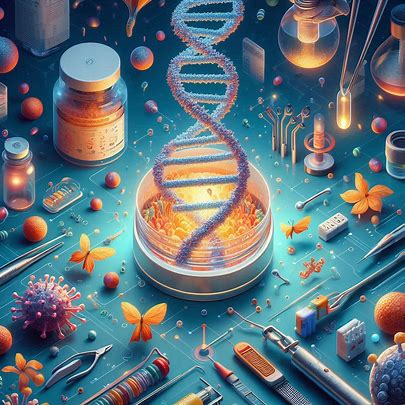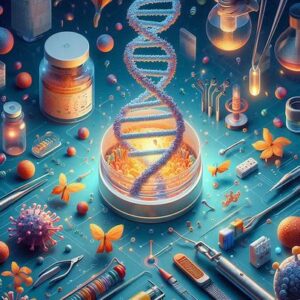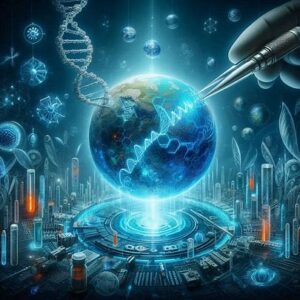
Introduction
Imagine a tool so precise it can snip and edit DNA—the blueprint of life—potentially curing genetic disorders, boosting crop yields, or even saving endangered animals. This is CRISPR-Cas9, a revolutionary gene-editing technology that’s transforming medicine, agriculture, and beyond. Often described as “molecular scissors,”” CRISPR, allows scientists to target and modify specific genes with unprecedented accuracy. For the general public, CRISPR sparks both excitement and ethical questions about its power to reshape life. This article explores what CRISPR-Cas9 is, how it works, its real-world applications, current trends, and its potential to redefine our future, all in an engaging and clear way.
What is CRISPR Gene Editing?
CRISPR (Clustered Regularly Interspaced Short Palindromic Repeats) is a gene-editing tool derived from a bacterial defense system. Originally, bacteria use CRISPR to detect and destroy invading viruses by cutting their DNA. Scientists adapted this mechanism, particularly the Cas9 enzyme, to edit genes in plants, animals, and humans with remarkable precision.
Key Components of CRISPR-Cas9
- Guide RNA (gRNA): A molecule that directs Cas9 to a specific DNA sequence, like a GPS for genes.
- Cas9 Enzyme: Acts as the “scissors,”” cutting the DNA at the targeted spot.
- Repair Mechanism: After the cut, the cell’s natural repair system fixes the DNA, either by inserting, deleting, or replacing genetic material.
For example, if a gene causes a disease, CRISPR can target it, cut it out, and replace it with a healthy version, potentially curing the condition.
How CRISPR Works
CRISPR-Cas9 edits genes through a precise, multi-step process:
- Targeting: Scientists design a gRNA to match the DNA sequence of the target gene.
- Binding: The gRNA guides Cas9 to the exact location on the DNA strand.
- Cutting: Cas9 slices the DNA, creating a double-strand break.
- Repair: The cell repairs the break, either randomly (disrupting the gene) or using a provided DNA template to insert new genetic material.
- Outcome: The edited gene may correct a defect, enhance a trait, or disable harmful DNA.
For instance, to treat sickle cell anemia, CRISPR can edit the faulty gene in blood cells, enabling them to produce healthy hemoglobin.
Real-World Applications of CRISPR
CRISPR’s versatility is driving breakthroughs across multiple fields, offering solutions to some of humanity’s biggest challenges.
Medicine
CRISPR is revolutionizing treatments for genetic diseases. In 2023, the FDA approved Casgevy, a CRISPR-based therapy for sickle cell disease, marking a milestone in gene therapy. Clinical trials are exploring CRISPR for conditions like cystic fibrosis, muscular dystrophy, and inherited blindness. It’s also being tested against cancer by editing immune cells to better attack tumors.
Agriculture
CRISPR enhances crops by improving yield, resilience, and nutrition. For example, scientists have developed CRISPR-edited wheat resistant to fungal diseases, reducing pesticide use. In 2024, CRISPR-edited bananas with longer shelf lives hit markets, addressing food waste. Gene-edited livestock, like hornless cattle, improve animal welfare and farming efficiency.
Environmental Conservation
CRISPR aids conservation efforts. Researchers are using it to protect coral reefs by editing genes to withstand warmer oceans. In Australia, CRISPR is being explored to control invasive species like cane toads by altering their reproduction genes, preserving native ecosystems.
Infectious Disease Control
CRISPR can combat diseases like malaria by editing mosquito genes to prevent them from carrying the parasite. Trials in Africa are testing gene-edited mosquitoes that pass on infertility, reducing populations of disease-carrying species.
Biotechnology
CRISPR is used to engineer microbes for industrial purposes. Companies like Ginkgo Bioworks use CRISPR to create bacteria that produce biofuels, fragrances, or pharmaceuticals, offering sustainable alternatives to traditional manufacturing.

Current Trends in CRISPR
As of June 2025, CRISPR is advancing rapidly, driven by innovation and growing acceptance. Here are key trends:
Improved Precision
New CRISPR variants, like prime editing and base editing, allow finer changes to DNA without double-strand breaks, reducing unintended edits. These tools, developed by researchers like David Liu, enhance safety for medical applications.
CRISPR 2.0 Tools
Beyond Cas9, enzymes like Cas12 and Cas13 target different genetic material, including RNA. Cas13, for instance, is used in diagnostics to detect viruses like COVID-19 with high sensitivity, as seen in Sherlock Biosciences’ tests.
Ethical and Regulatory Progress
Global discussions are shaping CRISPR’s ethical use. The WHO and UNESCO are developing guidelines for human gene editing, balancing innovation with concerns about “designer babies.”” In 2024, the UK approved limited CRISPR trials for embryonic research, with strict oversight.
Delivery Innovations
Delivering CRISPR components into cells remains challenging. Lipid nanoparticles and viral vectors are improving delivery for therapies, while non-viral methods, like electroporation, are gaining traction for safer applications.
Public Accessibility
CRISPR kits for educational use, like those from Odin, are democratizing gene editing, allowing students and hobbyists to experiment with bacteria. This trend fosters innovation but raises biosecurity concerns.
Benefits of CRISPR
CRISPR offers transformative advantages:
- Precision: Targets specific genes with minimal off-target effects.
- Versatility: Applicable to humans, plants, animals, and microbes.
- Cost-Effectiveness: Cheaper and faster than older gene-editing methods.
- Health Impact: Potential to cure genetic diseases and enhance immunity.
- Sustainability: Improves agriculture and reduces environmental harm.
Challenges of CRISPR
Despite its promise, CRISPR faces hurdles:
- Off-Target Effects: Unintended DNA edits could cause harm, requiring rigorous testing.
- Ethical Concerns: Editing human embryos or creating enhanced traits raises moral debates.
- Regulatory Gaps: Global rules vary, complicating safe and equitable use.
- Delivery Barriers: Getting CRISPR into the right cells, especially in organs like the brain, is complex.
- Public Trust: Misinformation and past controversies, like the 2018 CRISPR baby scandal, fuel skepticism.
Addressing these requires robust research, ethical frameworks, and transparent communication.
The Future of CRISPR
CRISPR’s potential is vast, with profound impacts by 2030:
- Universal Therapies: Affordable CRISPR treatments could eradicate many genetic diseases.
- Climate-Resilient Agriculture: Gene-edited crops and livestock will support food security in changing climates.
- Biodiversity Protection: CRISPR could revive endangered species or protect ecosystems from invasive threats.
- Personalized Medicine: Tailored CRISPR therapies will target individual genetic profiles.
Global collaboration, ethical oversight, and public engagement will ensure CRISPR’s benefits are realized responsibly.

Conclusion
CRISPR gene editing is a groundbreaking tool, offering hope for curing diseases, feeding the world, and protecting our planet. Its precision and versatility make it a cornerstone of modern science, with applications from medicine to conservation. As trends like improved precision, new tools, and ethical guidelines shape its evolution, CRISPR promises a future where we can rewrite the code of life for the better. By addressing challenges like safety and ethics, CRISPR can unlock a healthier, more sustainable world, empowering humanity to tackle its greatest challenges.



